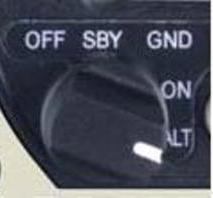| Post: | LVNL
Aeronautical Information Service
P.O. Box 75200
1117 ZT Schiphol
The Netherlands | | Tel: | +31 (0)20 406 3520 | | Email: | [email protected] |
| Aeronautical Information Circular
NETHERLANDS | AIC-A 05/2022 Publication date 15 DEC 2022 |
IMPORTANCE OF CORRECT USE OF THE MODE S TRANSPONDER REGARDING COLLISION AVOIDANCE
1 INTRODUCTION
The purpose of this AIC is to inform general aviation pilots (including glider and balloon pilots) of the importance of the correct use of the mode S transponder and how to select the correct setting of the transponder.
The mode S transponder should always be activated with the selected mode ACS or ALT (depending on the type of transponder). Only when the mode ACS or ALT is selected, the altitude information (mode C) will be provided by the transponder.
The mode S transponder reports besides mode S information (consisting of the 24 bits ICAO address and aircraft identification) also mode A (a 4 digit octal code) and mode C (pressure altitude) information. Air traffic controllers observe that the transponder altitude information (mode C) of general aviation on a VFR flight is not always displayed on the radar screen. Investigations prove that this is caused by incorrect use of the transponder and not by any technical malfunction.
Altitude information (mode C) is essential for the effectiveness of Air Traffic Control (ATC) safety nets, including the Airborne Collision Avoidance Systems (ACAS). The regulation "Regeling boorduitrusting" requires that altitude information (mode C) should always be selected simultaneously with mode S.
2 TRANSPONDER OPERATION
| Examples of mode selection keys: |
|---|
| | |
A mode S transponder can be selected in the following modes:
- Depending on the type of transponder.
|
| OFF: | Powers off the transponder. |
| STBY or SBY 1): | Selects the standby mode. When in standby mode, the transponder will not reply to any interrogations. |
| AS or ON 1): | Selects mode A and mode S. The transponder signals do not include altitude information. |
| ACS or ALT 1): | Selects mode A, mode C (altitude information) and mode S. |
3 AIR TRAFFIC CONTROL SAFETY NETS
To minimise the risk of a mid-air collision with commercial air transport and military jet traffic, the Minister of Infrastructure and Environment and the Minister of Defence have taken measures to expand the mandatory use of mode S SSR transponders.
Mode S and mode C (altitude information) are used by the following ATC safety nets:
- air traffic controllers for separation purposes or to provide flight information;
- short term conflict alert (STCA) systems that alert controllers of a potential loss of separation used in some ground-based Air Traffic Control systems;
- airborne collision avoidance systems (ACAS) which generate mid-air collision alerts in the event that normal means of providing separation between aircraft should fail;
- radar displays on board military jets.
ATC safety nets rely heavily on mode S and mode C information. It is therefore important that pilots operating in all airspace classes are aware of the significant impact incorrect setting of mode S SSR transponders can have on the effectiveness of the ATC safety nets.
Pilots should therefore activate the transponder in the correct mode ACS or ALT.
4 WORKING OF ACAS
The key significance of the correct setting of the transponder is illustrated as follows. The pilot of a TCAS II equipped aircraft, which is in potential conflict with another aircraft, will be provided with the following protection:
- If the other aircraft is not transponder equipped or has the transponder selected to OFF or STANDBY: no protection is offered.
- If the other aircraft has the transponder merely selected to ON (mode A): only a traffic advisory (TA) will be provided. Although this can help the pilot of the TCAS II equipped aircraft to achieve subsequent visual contact, there is no associated altitude information and it will not be possible to determine whether the conflicting aircraft is at a similar altitude.
- If the other aircraft has the transponder selected to ACS or ALT (mode A and mode C altitude information): both a traffic advisory (TA) and, where appropriate, a resolution advisory (RA) will be provided. The RA will provide guidance in the vertical plane for the pilot of the TCAS II equipped aircraft, which will (when followed by this pilot) protect both aircraft from collision.
5 ADDITIONAL INFORMATION
For additional information or questions about this AIC-A, please contact:
| Post: | Civil Aviation Authority Netherlands (CAA NL)
P.O. Box 90653
2509 LR The Hague
The Netherlands |
| Tel: | +31 (0)88 489 0000 |
| URL: | www.ilent.nl/contact (available in English and Dutch) |
6 DOCUMENT CONTROL
This AIC-A replaces AIC-A 06/11 dated 06 OCT 11.
ISSN: 1386-6605


